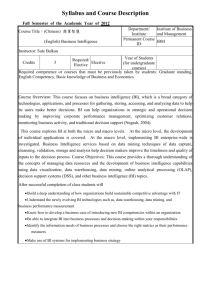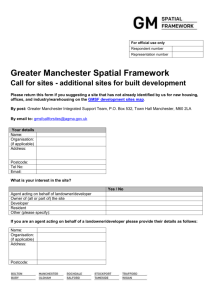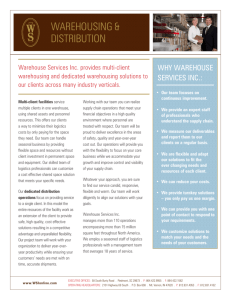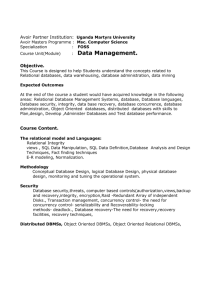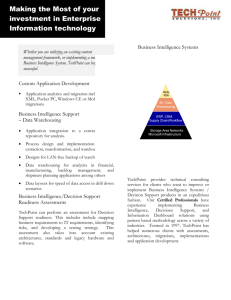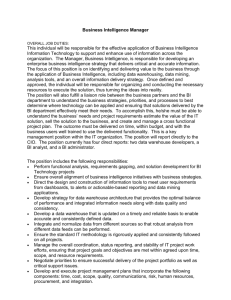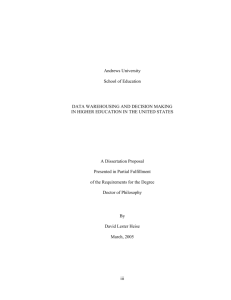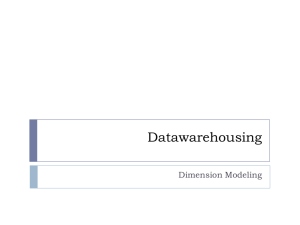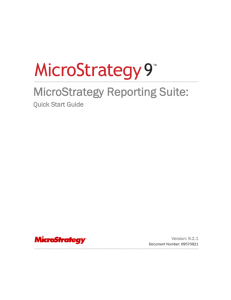表4-4
advertisement
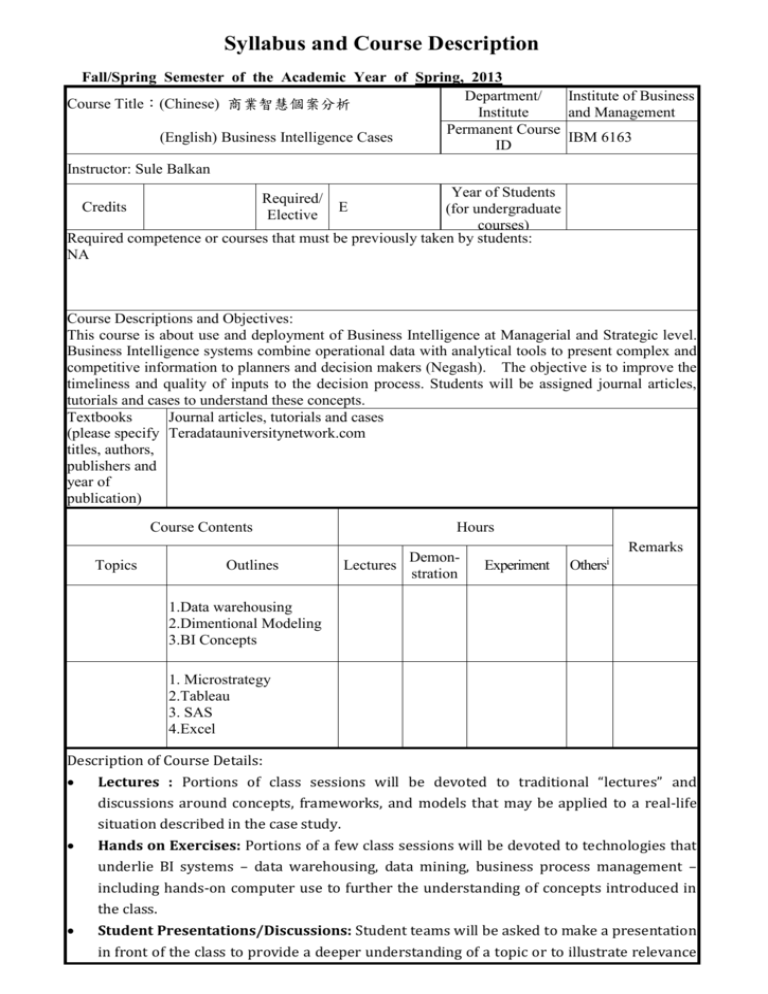
Syllabus and Course Description Fall/Spring Semester of the Academic Year of Spring, 2013 Department/ Institute of Business Course Title:(Chinese) 商業智慧個案分析 Institute and Management Permanent Course (English) Business Intelligence Cases IBM 6163 ID Instructor: Sule Balkan Year of Students (for undergraduate courses) Required competence or courses that must be previously taken by students: NA Required/ Elective Credits E Course Descriptions and Objectives: This course is about use and deployment of Business Intelligence at Managerial and Strategic level. Business Intelligence systems combine operational data with analytical tools to present complex and competitive information to planners and decision makers (Negash). The objective is to improve the timeliness and quality of inputs to the decision process. Students will be assigned journal articles, tutorials and cases to understand these concepts. Textbooks Journal articles, tutorials and cases (please specify Teradatauniversitynetwork.com titles, authors, publishers and year of publication) Course Contents Topics Outlines Hours DemonLectures stration Remarks Experiment i Others 1.Data warehousing 2.Dimentional Modeling 3.BI Concepts 1. Microstrategy 2.Tableau 3. SAS 4.Excel Description of Course Details: Lectures : Portions of class sessions will be devoted to traditional “lectures” and discussions around concepts, frameworks, and models that may be applied to a real-life situation described in the case study. Hands on Exercises: Portions of a few class sessions will be devoted to technologies that underlie BI systems – data warehousing, data mining, business process management – including hands-on computer use to further the understanding of concepts introduced in the class. Student Presentations/Discussions: Student teams will be asked to make a presentation in front of the class to provide a deeper understanding of a topic or to illustrate relevance of the topic to real-life situations. Homework assigned will mainly consist of preparing such presentations or Chapter Quizzes In-class Work: Students will be asked to work individually or in teams on topics of the day, do problem solving, generate ideas, write short answers to questions, etc. Quizzes: 150 points (15X10) Multiple Choice Quiz from the readings that will be discussed that day. If you will be absent from the class please provide proper documentation. Homework and Assignments: 150 points (30X5): Homework assignments will be given from the textbook or from the Teradata University Network site. Students will share their work in class in rotation. Group Project 200 pts.: In this assignment you are being asked to work in teams of 3 to assess an important emerging trend in the area of how data warehousing and business intelligence is used in the area of Marketing. Your assessment will result in a 30 minute presentation with 5 minutes for Q&A. Please bring a hard copy of your presentation materials (a well written research paper and power point (or other medium like prezi) presentation) for review the instructor. You will prepare a power point presentation and a 10-15 page business report (template will be shared) There is considerable flexibility in what can be done, and creativity is encouraged. You are welcome to give software demonstrations, compare products in the market, present a case study, give an update on current practices, etc. When creating your presentation, please focus on communicating depth within your topic, not breadth. The presentations are graded based on the group’s demonstrated depth of knowledge on the topic and the ability to communicate useful, relevant information about the topic to their peers. In other words, the group needs to add value to their peers so that their peers can leave and apply their new topic understanding. Why should an IT manager care about your topic? And, how should the IT manager change people, processes, and technologies to best leverage the topic within his or her organization? Your presentation should cover at least the following. Topic Understanding. Your analysis should begin by defining your topic and presenting your topic within the warehousing and BI industry. In general, what exactly should your peers understand about this topic to manage it effectively? Business value. Assess the potential business value of your topic for organizations involved in warehousing and BI. In general, what should your peers consider when putting together a business case for this topic? Software demo or case studies. Place your topic within a context by presenting either 1) a software tool that represents the space under examination or 2) a case study of a company that is currently exploring and managing your topic. In general, how can you best communicate to your peers exactly what this topic is in a tangible way? Looking ahead. What next? Given your research and analysis of your topic, where do we go from here? In general, how can your peers best prepare to manage your topic in the future? Note: Make sure that as you cover these four basic areas, your presentation is communicated as a consistent and coherent overall story. Teams and topics: You will work in teams of 2. Each team will be assigned a different topic. By Monday, October 15th your team must email your 3 possible topic choices from the list below to sule@nctu.edu.tw. Topics will be assigned based on the order your requests were received, so please submit your choices as soon as possible. Please e- mail your topic requests in rank order of preference. Big Data Managing unstructured data Unstructured data warehouses per Bill Inmon; Text mining; Knowledge management in BI In-memory Analytics/In database Analytics Active data warehousing Mobile BI Social BI Privacy and BI Closed- loop processes, active warehousing techniques Integration platforms or warehouse appliances EII, virtual warehousing, appliances like Netezza Microsoft or SAP as viable enterprise analytical solutions The importance of data visualization Using warehousing/BI to measure business performance Time Slot Location Contact Information Office Hours Tuesday Thursday 12:00-1:00 IBMA303 12:00-1:00 M116 Syllabus Week 1 2 2/19 Course Objectives and Syllabus Review 2/26 TUN website and review of topics and cases 3/5 3 Contents/Topic Date Log on to TUN create and account and browse materials Discuss Current State of BI and the BI Tutorial Past, Current and Future Applebee’s video. (Available on the Teradata Student Network) Download and Read from TUN Watson "Business Intelligence Past, Current and Future" 4 5 6 7 3/12 Introduction to Data Modeling-Dimentional Modeling 3/19 Access Creating Data Base -West Bridge Travel Trips 3/26 Students read TUN-Dimensional Modeling Tutorial Read the power points on Access Access Mackelby Case Read the power points on Access 4/2 Group Meeting 4/9 BI Capabilities and Gartner’s Magic Quadrant and the Economist Report Discussion 8 4/16 9 Download and Read from TUN: Economist Special Report: Data Data Everywhere Data Warehousing Read "Which Data Warehouse Architeture is More Successful?" article 10 4/23 No class today Students work on their projects 11 4/30 Data warehousing Supports Corporate Strategy at First American Corporation 5/7 Top 10 BI Vendors 12 13 5/14 Watson, “Future Directions for BI Software,” Business Intelligence Journal, 2nd Quarter 2008. 5/21 Big Data Tutorial 14 15 Students read Top10 BI Vendors and each group prepare 10 min ppt on a BI Vendor 5/28 Read “Big Data is Scaling BI and Analytics,” Information Management Magazine,” Sept/Oct 2011. “Catalina Marketing Aims for the Cutting Edge of ‘Big Data’,” Information Week, September 14, 2011 Microstrategy Microstrategy section at TUN 16 6/4 Student presentations 17 6/11 Student presentations 18 6/18 Remarks: 1、Inclusive of visiting institutes/organizations outside the NCTU or other academic events. 2、Please adhere to pertinent regulations/laws on intellectual property rights. Do not use pirated textbooks. 附件三
